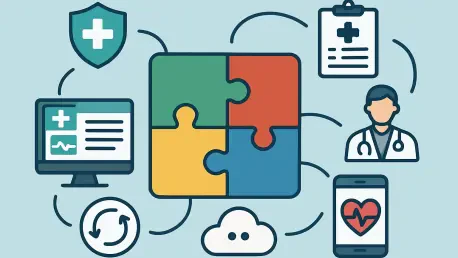In an era where healthcare is increasingly driven by data, the ability to share and analyze patient information across diverse systems holds the key to transformative outcomes in both clinical care and research. Picture a world where a hospital in one country can instantly access critical patient records from another, enabling swift, life-saving decisions, or where researchers can pool data from millions of individuals to uncover patterns in rare diseases. This vision, however, remains elusive due to fragmented data formats, stringent privacy regulations, and technical incompatibilities that create silos of invaluable information. The solution lies in the adoption of Common Data Models (CDMs) and data standards, which serve as the backbone for harmonizing health data to achieve interoperability and facilitate federated analysis. Frameworks such as i2b2, Sentinel CDM, PCORnet CDM, and OMOP CDM, alongside standards like HL7 version 2, Clinical Document Architecture (CDA), Fast Healthcare Interoperability Resources (FHIR), and openEHR, are at the forefront of this effort. By delving into their unique capabilities, this exploration aims to illuminate how these tools address the pressing challenges of data sharing, guiding healthcare providers, researchers, and policymakers toward informed choices. Standardization is not merely a technical endeavor; it is a fundamental pillar for advancing medical innovation, enabling everything from real-time clinical insights to large-scale, collaborative studies that shape the future of healthcare delivery.
The Urgency of Standardizing Health Data
The current landscape of health data resembles a complex mosaic, with disparate systems, formats, and terminologies creating significant barriers to effective collaboration across healthcare entities. Hospitals and clinics often operate on entirely different platforms, even within the same region, leading to inefficiencies when attempting to exchange vital patient information. Beyond technical discrepancies, privacy regulations impose strict controls on data access, further complicating the sharing process. Without a cohesive strategy, critical insights remain trapped within isolated databases, inaccessible to clinicians needing real-time information or researchers seeking to address global health challenges. The absence of standardization not only hampers individual patient care but also stifles broader efforts to leverage data for population health studies, leaving gaps in understanding and response capabilities.
Enter Common Data Models and data standards, which offer a promising pathway to dismantle these barriers by establishing a universal framework for health data. These tools aim to align diverse datasets under shared principles, often referred to as FAIR—Findability, Accessibility, Interoperability, and Reusability. By providing a common language, they enable seamless data exchange, whether for a physician accessing emergency records from another facility or a research team aggregating information across continents to study disease trends. This unified approach transforms fragmented data into a powerful resource, fostering advancements in personalized medicine and public health initiatives. The significance of standardization extends beyond mere convenience; it is a prerequisite for unlocking the full potential of health data in a globally connected world.
Unpacking Common Data Models for Data Harmony
Common Data Models, or CDMs, represent structured frameworks meticulously designed to organize health data for storage and analytical purposes, bridging the gap between varied sources like electronic health records (EHRs), insurance claims, and clinical notes. These models act as interpreters, converting heterogeneous datasets into a consistent format that different systems can understand, thereby facilitating meaningful analysis without the need for constant reformatting. Their primary role is to support research and large-scale studies by ensuring that data from multiple origins can be integrated into a cohesive whole, paving the way for insights that would otherwise remain obscured by incompatibility. CDMs are indispensable in federated research environments where data remains localized for privacy but contributes to collective findings through standardized structures.
Diving deeper, specific CDMs cater to distinct needs within the healthcare ecosystem, each with tailored strengths that address unique challenges. For instance, i2b2 emphasizes flexibility, allowing institutions to customize the model for unique research projects, making it a favorite for localized studies. In contrast, OMOP CDM enforces rigorous consistency through its expansive network, ideal for broad, observational research spanning multiple countries. PCORnet CDM focuses on clinical research, connecting numerous U.S. hospitals for collaborative efforts, while Sentinel CDM hones in on drug safety surveillance, serving regulatory bodies with a specialized scope. Though their focuses differ, all CDMs share a commitment to enabling data-driven discoveries by providing a uniform foundation, ensuring that health information can be leveraged effectively across diverse applications and settings.
Data Standards as Pillars of Information Exchange
While CDMs excel in organizing data for analysis, data standards play a complementary role by governing how information is captured and exchanged between systems, ensuring smooth communication in daily healthcare operations. These standards act as the conduits through which patient data flows from one facility to another, maintaining clarity and usability regardless of the underlying technology. They often integrate standardized terminologies like SNOMED CT to align medical concepts, ensuring that a diagnosis or treatment recorded in one system retains its meaning in another. Unlike CDMs, their focus is less on long-term storage for research and more on immediate, practical interoperability in clinical environments, making them vital for real-time decision-making.
Among the prominent data standards, each brings unique capabilities to the table, addressing different facets of data exchange. HL7 Version 2, a long-standing standard, underpins basic messaging in numerous hospitals, though its age shows in limited modern features. CDA specializes in structured documents, ideal for sharing comprehensive patient summaries. FHIR stands out with its web-based architecture, enabling dynamic, real-time data sharing through modern APIs, while openEHR prioritizes detailed clinical data for sophisticated decision-support tools. Together, these standards form a critical counterpart to CDMs, ensuring that data not only resides in a harmonized format but also moves fluidly across the healthcare landscape, supporting everything from routine care coordination to emergency responses.
Assessing Suitability Across Varied Applications
When it comes to addressing the diverse array of data types and use cases in healthcare, not all CDMs and standards perform with equal efficacy, as their designs cater to specific priorities. OMOP CDM demonstrates remarkable versatility, accommodating a wide spectrum of data from EHRs to unstructured medical notes, making it a robust choice for multifaceted research endeavors. PCORnet CDM, while strong with structured clinical data, faces challenges with less formatted inputs like free-text entries, limiting its scope in certain contexts. i2b2 offers a customizable approach, ideal for niche projects where tailored data handling is paramount, though it may lack the breadth needed for expansive studies. Sentinel CDM, with its narrow focus on drug safety monitoring, excels in regulatory settings but falls short for broader health inquiries, highlighting the importance of aligning a model’s strengths with intended goals.
Turning to data standards, their suitability varies based on the demands of specific healthcare scenarios, and choosing the right one is crucial for effective data management. FHIR emerges as a leader with its flexible, modern design, capable of supporting an extensive range of data sources and real-time applications, making it perfect for dynamic clinical environments. openEHR shines in managing complex clinical information, offering depth for detailed patient care and decision-making processes. CDA proves effective for document-based exchanges, such as sharing patient histories, but struggles with the agility required for immediate data needs. HL7 Version 2, despite its widespread historical use, appears outdated when confronted with contemporary, diverse data challenges, often failing to meet the needs of newer systems. Selecting the appropriate tool hinges on a clear understanding of whether the focus lies in research depth, clinical immediacy, or regulatory precision, ensuring that data management aligns with operational objectives.
Measuring Adoption and Community Strength
The widespread adoption and community backing of a data model or standard often serve as key indicators of its reliability and potential for long-term impact in the healthcare sector. OMOP CDM stands at the forefront, supported by the OHDSI network, which spans over 30 countries and encompasses billions of patient records, reflecting a global reach that fosters collaborative research. PCORnet CDM maintains a significant presence in the U.S., bolstered by networks like PopMedNet that connect numerous hospitals for shared clinical studies. i2b2, adopted by hundreds of organizations, benefits from tools like SHRINE that enable joint query capabilities, while Sentinel CDM, though impactful with a vast patient database, remains constrained by its exclusive access through U.S. FDA channels, limiting its broader applicability.
Among data standards, FHIR commands a dominant position with its global uptake, further amplified by its proven utility in high-stakes scenarios such as vaccine surveillance during health crises like COVID-19. openEHR enjoys a dedicated user base, particularly in Europe, where its clinical focus resonates with healthcare providers seeking detailed data structures. CDA continues to hold relevance in specific document-sharing applications, though its influence wanes compared to more contemporary alternatives. HL7 Version 2 persists in many hospitals due to entrenched legacy systems, yet its declining appeal underscores a shift toward newer frameworks. The strength of a model’s community often translates into richer resources, frequent updates, and collective problem-solving, all of which enhance its practical value and drive sustained adoption across diverse healthcare landscapes.
Flexibility in an Evolving Healthcare Landscape
As healthcare continues to evolve with technological advancements and shifting priorities, the adaptability of CDMs and data standards becomes a crucial factor in their relevance and utility over time. i2b2 distinguishes itself with exceptional flexibility, granting users the freedom to modify and extend the model to suit localized research requirements, making it a go-to for bespoke projects. OMOP CDM, while capable of adaptation, imposes stricter guidelines to preserve data consistency across its extensive network, which can sometimes hinder rapid modifications. PCORnet CDM permits limited extensions but leans heavily on standardized governance to maintain uniformity, potentially curbing innovation in specific contexts. Sentinel CDM, bound by its specialized focus on drug safety, offers minimal room for deviation, restricting its ability to pivot to emerging needs.
In the realm of data standards, adaptability manifests through integration with cutting-edge technologies and evolving use cases, ensuring that systems remain relevant in a rapidly changing environment. FHIR excels with its extensible framework, leveraging web APIs to seamlessly connect with modern healthcare applications and accommodate new functionalities. openEHR’s archetype-based system allows for the creation of custom data structures while preserving interoperability, catering to nuanced clinical demands. CDA provides moderate adaptability for document formats but lacks the agility to embrace broader technological shifts. HL7 Version 2, rooted in outdated methodologies, struggles to keep pace with innovation, offering limited updates or capacity for novel applications. While adaptability ensures that a model remains pertinent amid change, excessive flexibility can jeopardize data consistency, necessitating a delicate balance to maintain both relevance and reliability across systems.
Interoperability at the Heart of Data Sharing
At the core of health data standardization lies interoperability, the essential capability that ensures data can be exchanged and understood across disparate systems, enabling true collaboration in healthcare. OMOP CDM sets a high bar by rigorously mapping data to standardized terminologies like SNOMED CT, fostering seamless integration, though this process occasionally results in the loss of granular details during conversion. PCORnet CDM similarly emphasizes standard concepts, bolstering its effectiveness in federated research environments where consistency is paramount. i2b2, however, falls behind in this domain, as it does not distinctly separate local and standard terminologies, which can impede its utility in broader, collaborative settings. Sentinel CDM, given its specialized regulatory focus, places minimal emphasis on wide-ranging interoperability, aligning instead with niche objectives.
Among data standards, interoperability remains the linchpin of their design, directly impacting their ability to facilitate fluid data exchange across various systems and platforms in healthcare. FHIR emerges as a frontrunner, incorporating mandatory resources and terminology support to guarantee smooth communication across platforms, making it ideal for real-time clinical needs. openEHR achieves semantic interoperability by decoupling data representation from content, ensuring meaning is preserved across contexts. CDA integrates effectively with standardized terminologies for document exchange but lacks the dynamism required for instantaneous data sharing. HL7 Version 2 struggles significantly, devoid of inherent support for modern interoperability demands, rendering it less competitive. Interoperability transcends being a mere feature; it is the cornerstone of collaborative healthcare, unlocking the potential for integrated solutions that span institutions and borders.
Ease of Use and Support Ecosystems
The practical effectiveness of a data model or standard often hinges on its usability and the robustness of the support systems available to implement and maintain it. OMOP CDM offers an exemplary support ecosystem, featuring platforms like ATLAS for data analysis and educational resources through initiatives such as the EHDEN Academy, which aid users in navigating its complexities. PCORnet CDM provides well-structured documentation and centralized access points, though it falls short in offering comprehensive analysis tools, which can limit its appeal for certain research applications. i2b2 benefits from an intuitive design that simplifies initial adoption, yet incomplete user guides can pose challenges for those seeking deeper implementation. Sentinel CDM delivers strong tools for data quality assurance, but its restricted access narrows its user base to specific regulatory entities, reducing broader applicability.
Data standards also vary widely in their ease of use and the resources they provide to support adoption across healthcare settings. FHIR stands out for its user-friendly approach, complemented by extensive developer tools like HAPI FHIR, which streamline integration into existing systems. openEHR offers substantial resources but can be daunting due to the complexity of its archetype design, requiring more technical expertise. CDA’s usability is hampered by its intricate structure, with limited tools available to ease implementation efforts. HL7 Version 2 provides minimal support beyond basic frameworks, often leaving users to navigate significant hurdles independently. A robust support system is pivotal, particularly for organizations with constrained technical capacity, as it directly influences the speed and success of adopting these frameworks in real-world scenarios.
Safeguarding Data with Privacy and Security
Managing sensitive patient information demands stringent privacy and security measures to protect against breaches while enabling necessary data access for healthcare delivery and research. The OMOP CDM addresses this by supporting distributed networks that allow data to remain within local institutions, ensuring privacy during federated analyses without compromising collaborative potential. PCORnet CDM adopts a similar distributed approach, safeguarding data behind institutional firewalls while facilitating shared research efforts across its network. i2b2 provides flexibility in security configurations, but its reliance on local policies introduces variability that may lead to inconsistencies in protection levels. Sentinel CDM prioritizes privacy through tightly controlled access mechanisms aligned with regulatory requirements, ensuring data remains secure within its specialized scope.
Data standards, tasked with facilitating exchange, must equally prioritize security to maintain trust in the systems handling patient information. FHIR incorporates advanced features like encryption and authentication, offering a secure foundation for data sharing across platforms. openEHR aligns with clinical security needs, embedding robust mechanisms to protect sensitive data during exchange. CDA includes some security provisions, though they are less comprehensive compared to newer standards, potentially exposing vulnerabilities. HL7 Version 2 notably lacks inherent security features, deferring such responsibilities to end-users, which can create significant risks in implementation. Striking a balance between accessibility and protection remains a critical challenge, as any framework must ensure robust safeguards to maintain integrity and confidentiality in an increasingly interconnected healthcare environment.
Shaping the Future of Health Data Management
Reflecting on the comprehensive evaluation of Common Data Models and data standards, it became evident that each framework brought distinct strengths to the table, tailored to specific healthcare needs, while no single solution emerged as universally dominant. OMOP CDM distinguished itself with unparalleled suitability for expansive research, backed by a vast global network, whereas FHIR led among standards with its cutting-edge design and widespread adoption for real-time data exchange. Models like i2b2 provided critical adaptability for localized projects, and niche tools like Sentinel CDM addressed specialized regulatory demands with precision. The exploration underscored the transformative power of these tools in harmonizing fragmented data landscapes, paving the way for enhanced interoperability.
Looking ahead, the path forward involves leveraging transformation tools and bridging solutions to minimize the costs and data loss associated with switching between models, which is a vital step toward realizing FAIR principles. Strengthening community support, refining standard terminologies, and enhancing security protocols will be essential in driving broader adoption and ensuring data integrity. International collaboration must also be prioritized to address regional disparities in framework usage, as seen in successful cross-border applications during past global health crises. By focusing on integrating emerging technologies like artificial intelligence and improving ETL processes, stakeholders can further unlock the potential of these frameworks, ensuring that health data management continues to evolve in step with technological advancements and global healthcare demands.









